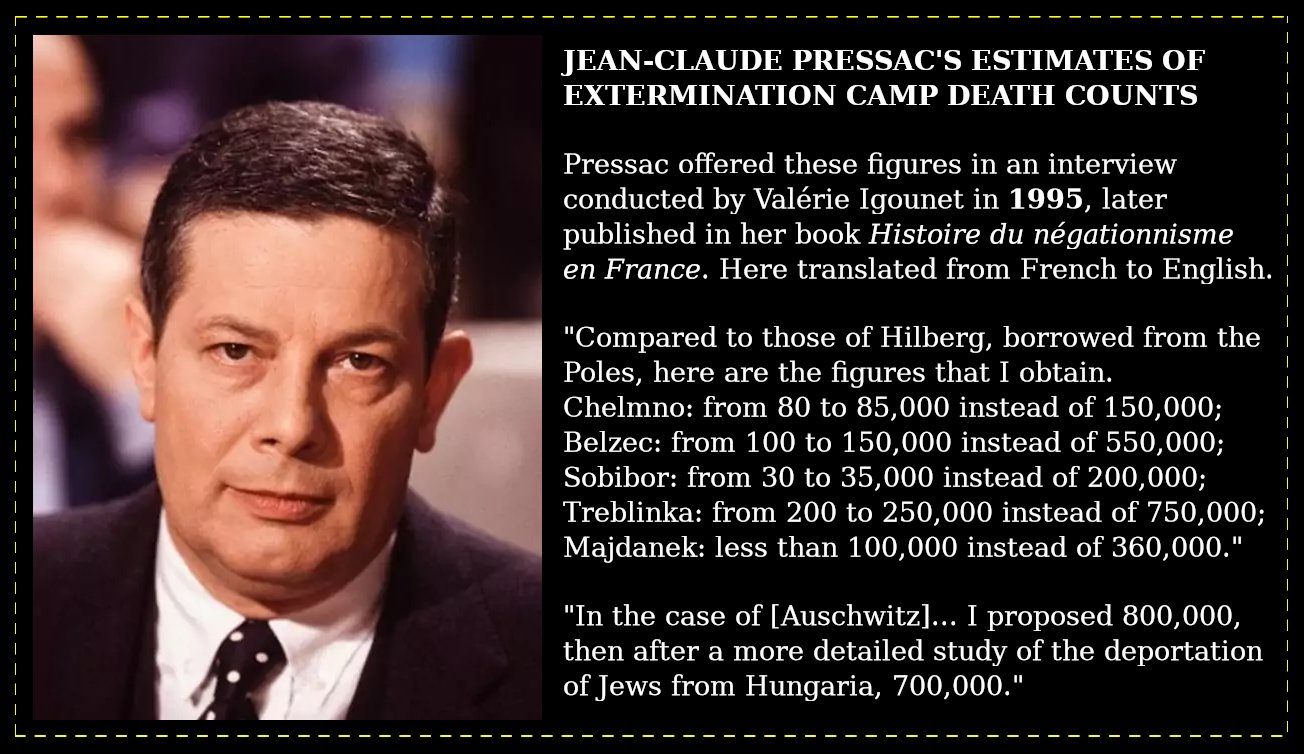Jean Claude Pressac
Posted: Sat Jul 26, 2025 1:55 pm
Why did Pressac change his mind about the Holocaust?
Jean-Claude Pressac was a French pharmacist who initially became involved with Holocaust denial in the 1970s and early 1980s when he became associated with Robert Faurisson who denied that the Nazis used homicidal gas chambers to kill undesirables or war prisoners during WW2. Faurisson believed that the documents describing the gas chambers were either misinterpreted or forged.
Pressac was initially sympathetic to Faurisson’s arguments and set out to investigate Auschwitz in order to prove that gas chambers were a myth. Around 1979–1980, Pressac visited Auschwitz with the assistance of Polish authorities, who allowed him access to archives and the physical site, expecting him to conduct serious research.
Once at Auschwitz, Pressac encountered detailed documentation that he found overwhelming. He saw architectural blueprints for crematoria and gas chambers, construction records, invoices, and internal memos from SS architects and camp authorities, references to “gas-tight doors,” “Zyklon B introduction devices,” and other materials specifically designed for homicidal use. The physical structures that he saw corresponded with the documents and witness accounts. The volume of technical and logistical evidence was so much that it overturned his pre-existing beliefs.
He ultimately turned against Faurisson and other deniers, realizing that he had been misled by pseudoscience and conspiracy theories.
He later published "Auschwitz: Technique and Operation of the Gas Chambers" (1989) which was a monumental, highly technical study using Nazi documents, camp plans, and photographs. He believed that the denial arguments at the time were not just incorrect, but technically incompetent.
After visiting Soviet liberated archives in 1993, he further expanded his research and published "Les Crématoires d’Auschwitz" (1993).
Once Pressac approached the subject not as a polemicist, but as a technician, his work began to bridge the gap between historical narrative and forensic/technical detail.
Have any of you guys done any of your own primary research or visited the concentration camps? If you can convince me that anything you say is true, I would not hesitate to be honest about that with the Jewish community.
Jean-Claude Pressac was a French pharmacist who initially became involved with Holocaust denial in the 1970s and early 1980s when he became associated with Robert Faurisson who denied that the Nazis used homicidal gas chambers to kill undesirables or war prisoners during WW2. Faurisson believed that the documents describing the gas chambers were either misinterpreted or forged.
Pressac was initially sympathetic to Faurisson’s arguments and set out to investigate Auschwitz in order to prove that gas chambers were a myth. Around 1979–1980, Pressac visited Auschwitz with the assistance of Polish authorities, who allowed him access to archives and the physical site, expecting him to conduct serious research.
Once at Auschwitz, Pressac encountered detailed documentation that he found overwhelming. He saw architectural blueprints for crematoria and gas chambers, construction records, invoices, and internal memos from SS architects and camp authorities, references to “gas-tight doors,” “Zyklon B introduction devices,” and other materials specifically designed for homicidal use. The physical structures that he saw corresponded with the documents and witness accounts. The volume of technical and logistical evidence was so much that it overturned his pre-existing beliefs.
He ultimately turned against Faurisson and other deniers, realizing that he had been misled by pseudoscience and conspiracy theories.
He later published "Auschwitz: Technique and Operation of the Gas Chambers" (1989) which was a monumental, highly technical study using Nazi documents, camp plans, and photographs. He believed that the denial arguments at the time were not just incorrect, but technically incompetent.
After visiting Soviet liberated archives in 1993, he further expanded his research and published "Les Crématoires d’Auschwitz" (1993).
Once Pressac approached the subject not as a polemicist, but as a technician, his work began to bridge the gap between historical narrative and forensic/technical detail.
Have any of you guys done any of your own primary research or visited the concentration camps? If you can convince me that anything you say is true, I would not hesitate to be honest about that with the Jewish community.
